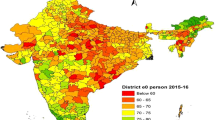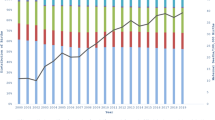Abstract
The Perinatal Periods of Risk (PPOR) methods provide the necessary framework and tools for large urban communities to investigate feto-infant mortality problems. Adapted from the Periods of Risk model developed by Dr. Brian McCarthy, the six-stage PPOR approach includes epidemiologic methods to be used in conjunction with community planning processes. Stage 2 of the PPOR approach has three major analytic parts: Analytic Preparation, which involves acquiring, preparing, and assessing vital records files; Phase 1 Analysis, which identifies local opportunity gaps; and Phase 2 Analyses, which investigate the opportunity gaps to determine likely causes of feto-infant mortality and to suggest appropriate actions. This article describes the first two analytic parts of PPOR, including methods, innovative aspects, rationale, limitations, and a community example. In Analytic Preparation, study files are acquired and prepared and data quality is assessed. In Phase 1 Analysis, feto-infant mortality is estimated for four distinct perinatal risk periods defined by both birthweight and age at death. These mutually exclusive risk periods are labeled Maternal Health and Prematurity, Maternal Care, Newborn Care, and Infant Health to suggest primary areas of prevention. Disparities within the study community are identified by comparing geographic areas, subpopulations, and time periods. Excess mortality numbers and rates are estimated by comparing the study population to an optimal reference population. This excess mortality is described as the opportunity gap because it indicates where communities have the potential to make improvement.


Similar content being viewed by others
References
Mathews, T. J., & MacDorman, M. F. (2004). Infant mortality statistics from the period linked birth/infant death data set. National Vital Statistics Reports, 2007(55), 1–32.
Centers for Disease Control and Prevention. (2005). Racial/ethnic disparities in infant mortality—United States, 1995–2002. MMWR, 54, 553–556.
Lu, M. C., & Halfon, N. (2003). Racial and ethnic disparities in birth outcomes: A life-course perspective. Maternal Child Health Journal, 7, 13–30.
Wise, P. H. (2003). The anatomy of a disparity in infant mortality. Annual Reviews of Public Health, 24, 341–362.
Pestronk, R. M., & Franks, M. L. (2003). A partnership to reduce African American infant mortality in Genesee County, Michigan. Public Health Report, 118, 324–335.
Cottrell, B. H., & Shannahan, M. (2004). Maternal bacterial vaginosis, fetal/infant mortality in eight Florida counties, 1999 to 2000. Public Health Nursing, 2004(21), 395–403.
Burns, P. G. (2005). Reducing infant mortality rates using the perinatal periods of risk model. Public Health Nursing, 22, 2–7.
Besculides, M., & Laraque, F. (2005). Racial and ethnic disparities in perinatal mortality: Applying the perinatal periods of risk model to identify areas of intervention. Journal of the National Medical Association, 97, 1128–1132.
Cai, J., et al. (2005). Perinatal periods of risk: An analysis of fetal-infant mortality rates in Kansas City, Missouri. Maternal and Child Health Journal, 9, 199–205.
Cai, J., et al. (2007). Perinatal periods of risk analysis of infant mortality in Jackson County, Missouri. Journal of Public Health Management and Practice, 13, 270–277.
WHO, CDC, CARE. (2009). WHO Collaborating Center in Reproductive Health (CDC), CCHI Care, CDC Health Inititiative, and The Health Unit—CARE. Lawn, J., McCarthy, B., & Ross, S. R. The healthy newborn: a reference manual for program managers. http://www.careusa.org/careswork/whatwedo/health/hpub.asp. Accessed December 16, 2009.
Heaman, M., et al. (2002). Preventable feto-infant mortality application of a conceptual framework for perinatal health surveillance to Manitoba perinatal outcomes. Canadian Journal of Public Health, 93(Suppl 2), S27–S32.
Peck, M. G., Sappenfield, W. M., & Skala, J. (in press). Perinatal periods of risk: A community approach for using data to improve women and infants’ health. Maternal and Child Health Journal.
Sappenfield, W. M., Peck, M. G., Haynatzka, V. R., Gilbert, C. S., & Bryant, T. (in press). Phase 2 analytic methods for further investigating feto-infant mortality. Maternal and Child Health Journal.
CityMatCH. (2008). Training opportunities: perinatal periods of risk. http://www.citymatch.org/ppor_index.php . Accessed July 5, 2008.
Kogan, M. D., et al. (1998). The changing pattern of prenatal care utilization in the United States, 1981–1995, using different prenatal care indices. The Journal of the American Medical Association, 279, 16233–16238.
Alexander, G. R., et al. (2008). Infant mortality assessment manual. http://www.soph.uab.edu/mch-imrm/. Accessed July 5, 2008.
Alexander, G. R., Kogan, M. D., & Himes, J. H. (1999). 1994–1996 U.S. singleton birth weight percentiles for gestational age by race, Hispanic origin and gender. Maternal and Child Health Journal, 3, 225–231.
National Center for Health Statistics. (1995). Division of vital statistics. Instruction manual part 12: Computer edits for natality data, effective 1993, Hyattsville, MD.
Taffel, S., Johnson, D., & Heuser, R. (1982). A method of imputing length of gestation on birth certificates. Vital and Health Statistics, Series 2, 93, 1–11.
Sappenfield, B., & Haynatzka, V. (2001). Periods of risk practice collaborative: Frequently asked data and analytic questions. http://webmedia.unmc.edu/community/citymatch/PPOR/howto/AnalyticIssuesextra.pdf. Accessed July 5, 2008.
Centers for Disease Control and Prevention. (2007). Unregistered deaths among extremely low birthweight infants—Ohio, 2006. MMWR, 56, 1101–1103.
DiGiuseppe, D. L., et al. (2002). Reliability of birth certificate data: a multi-hospital comparison to medical records information. Maternal and Child Health Journal, 6, 169–179.
Martin, J. A., & Hoyert, D. L. (2002). The national fetal death file. Seminars in Perinatology, 26, 3–11.
Kung, H. C., Hoyert, D. L., Xu, J. Q., & Murphy, S. L. (2008). Deaths: Final data for 2005. National Vital Statistics Reports, 56(10), 117.
Beitsch, L. M., Mahan, C. S., & Cupoli, J. M. (1992). Healthy start strengthening public and private partnership. Florida Medical Association Journal, 79, 567–568.
Florida Department of Health. (2008). Florida’s healthy start. http://www.doh.state.fl.us/family/mch/hs/hs.html. Accessed July 6, 2008.
Coalition of Northeast Florida, Inc. (2008). Northeast Florida healthy start coalition. http://www.nefhealthystart.org/. Accessed July 6, 2008.
CityMatCH. (2008).Table 7A: The feto-infant mortality excess number and rate, and the excess number and rates for the four perinatal periods of risk components. http://webmedia.unmc.edu/community/citymatch/PPOR/NationalDataTables98-00/Table7A.pdf. Accessed July 5, 2008.
Alexander, G. R., et al. (2003). U.S. birth weight/gestational age-specific neonatal mortality: 1995–1997 Rates for Whites, Hispanics and Blacks. Pediatrics, 111, e61–e66.
Northam, S., & Knapp, T. R. (2006). The reliability and validity of birth certificates. Journal of Obstetric, Gynecologic, and Neonatal Nursing, 35, 3–12.
Zollinger, T. W., Przybylski, M. J., & Gamache, R. E. (2006). Reliability of Indiana birth certificate data compared to medical records. Annals of Epidemiology, 16, 1–10.
Martin, J. A., & Menacker, F. (2007). Expanded health data from the new birth certificate, 2004. National Vital Statistics Reports, 55(12), 1–22.
Acknowledgments
Thanks to Dr. Brian McCarthy for developing and sharing his original methods and encouraging us to modify the approach for use in U.S. cities. Thanks to the Perinatal Periods of Risk City Teams, Pat Simpson and Jennifer Skala for their help in developing and adapting the methods for use in urban communities. Special thanks to Dr. Milton Kotelchuck and Dr. Laurin Kasehagen for their advice in writing these articles for publication. This work was supported in part by the following Cooperative Agreements: Merging Research and Practice for Urban Child Health—TS-283-14/16 (under CDC Cooperative Agreement U50/CCU300860); Building Urban MCH Capacity—TS 0922 (under CDC Cooperative Agreement U50/CCU300860); Toward Greater Science Use in Urban Health Agencies—TS-1337 (under CDC Cooperative Agreement U50/CCU300860); and the Maternal, Infant, and Reproductive Health: Science-Based Capacity Building for Major Urban Public Health Agencies (5 U65 DP724969-05) between CityMatCH at the University of Nebraska Medical Center and the Centers for Disease Control and Prevention, National Center for Chronic Disease Prevention and Health Promotion, Division of Reproductive Health, with supplemental support from the National Center for Birth Defects and Developmental Disabilities, and the Health Resources and Services Administration, Maternal and Child Health Bureau. Additional support was provided by the National March of Dimes Birth Defects Foundation, and the University of Nebraska Medical Center, Department of Pediatrics.
Author information
Authors and Affiliations
Corresponding author
Additional information
The findings and conclusions in this article are those of the authors and do not necessarily represent the official position of the Centers for Disease Control and Prevention.
Rights and permissions
About this article
Cite this article
Sappenfield, W.M., Peck, M.G., Gilbert, C.S. et al. Perinatal Periods of Risk: Analytic Preparation and Phase 1 Analytic Methods for Investigating Feto-Infant Mortality. Matern Child Health J 14, 838–850 (2010). https://doi.org/10.1007/s10995-010-0625-4
Published:
Issue Date:
DOI: https://doi.org/10.1007/s10995-010-0625-4




